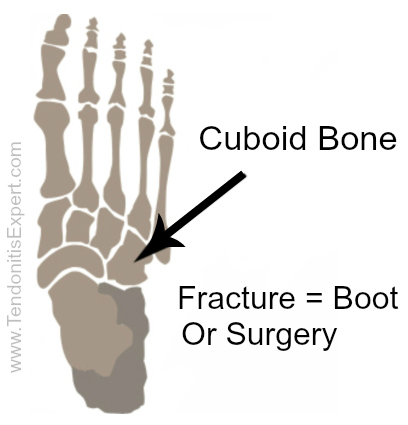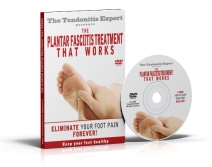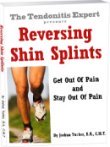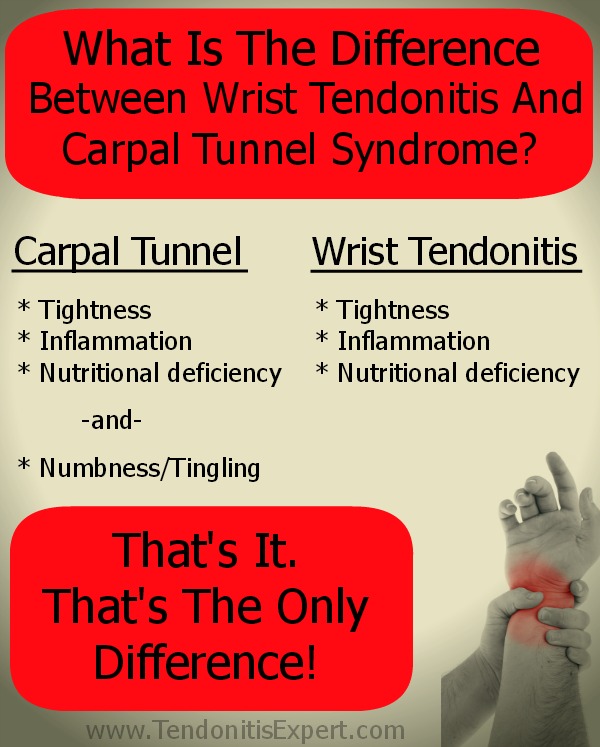Cuboid Fracture
A Cuboid Fracture puts your ability to stand at risk, and your ability to walk or run very likely out of the picture.
You want to avoid any break or fracture of -any- bone in the foot, including the cuboid bone.
If you think that you might have a fracture in the cuboid, you know there's a problem. You're going to need an xray and/or an MRI to confirm.
Chances are, if you're googling this keyword, you already know that you have a fractured cuboid.
What do you do about it?
Cuboid Fracture
Facts To Start Us Off
So let's take a look at some specifics about the foot in general and cuboid bone fractures in general
How many bones are in the foot?
There are 26 bones in the foot
How many metatarsal bones are there?
There are 5 metatarsal bones in the foot.
What causes a cuboid fracture?
Ultimately, compressive force causes fractures.
Traumatic compressive force, as from a car accident or sports (running, jumping) or...
Compressive 'stress' force, as from:
- having a shoe too tight whether standing/walking/running
- standing/walking/running on concrete or other hard surfaces
- when subject to a slow crushing weight
- etc

If I think I have a fractured cuboid bone, do I need an xray?
Yes. Only an xray can determine whether there is a fracture of a foot bone.
If it's a really small fracture, an MRI may be required.
Do I need a cast?
Probably not, unless you had major trauma to the foot and have pins and/or other hardware surgically put into the foot. That's usually a multi-bone injury scenario.
If you've fractured just the cuboid, you'll probably just have to wear a removable boot for a while.
Cuboid Fracture Symptoms
Symptoms of a cuboid bone fracture are....
The most common symptom is the inability to bear weight. This makes:
- running an impossibility
- walking a hardship if even possible
- standing a one legged ordeal
Other symptoms:
- bruising over/around the cuboid
- tenderness to the touch
- pain with a firmer touch
- a shortening of the outside of the foot (due to compressive forces moving the bone out of position)
Granted, depending on how acute the fracture is, and/or where you're at in the healing process, your symptoms may be a little better or a little worse.
WARNING!: Just because you can limp around on it doesn't mean that you should.
Don't.
How To Diagnose A
Cuboid Fracture
Only a X-ray can 'see' a fractured cuboid bone. And a doctor has to see the fracture to diagnose a fracture.
The bones of the foot are small. And if the fracture is small enough, even an Xray can't pick it up, an MRI will need to be used.
The good news is, the smaller the fracture, the better and faster your recovery will be.
'Foot pain' and 'inability to bear weight on the foot' are not indications of a fracture, per se. They are, however, big clues.
The doctor will (hopefully) poke and prod around the foot looking for tender/painful spots.
If you were in a car crash or had a weight dropped on the foot or were taken out of a sporting event due to sudden disabling pain, then the doctor might order Xrays even before actually seeing you.
If, for instance, you are a runner, and have developed foot pain, there may not be any obvious signs that you have a fractured cuboid...because any number of things could be causing your pain so it's not such an easy 'clue'.
Still, if you have a cuboid bone fracture, you'll end up at the hospital. It's not the kind of thing you just 'go easy' on for a couple days and you'll be fine.
You broke a bone in your foot. With our without surgery, will will have a Bone Bruise.
It's going to take some time to recovery.
Your job, well, you have two jobs:
- make that recovery as quickly as possibly
- Minimize the Pain Causing Dynamic and prevent the development of tendonitis.
Cuboid Fracture
What Will Doctors Do?
How doctors treat the fracture will depend on the severity.
If it is a small fracture and has not been displaced, they will most likely:
- confirm via an X-ray
- prescribe rest/staying off the foot
- prescribe a walking boot/splint/protective shoe
- prescribe pain killers and/or anti-inflammatory drugs
If is a small fracture and has been displaced:
- may require surgery to fix the position of the displaced bone
- will be placed into a cast/boot/splint/protective shoe as the doctor determines
If it's a large fracture and has not been displace (it almost certainly has been so this isn't likely):
- confirm via an X-ray
- prescribe rest/staying off the foot
- prescribe a walking cast/boot/splint/protective shoe
- prescribe pain killers and/or anti-inflammatory drugs
If it is a large fracture and HAS been displaced:
- most likely will need surgery with metal pins/plates/screws etc to reposition and stabilize the cuboid
- prescribed rest/staying off the foot
- lots of elevating the foot post-surgery
- prescribe pain killers and/or anti-inflammatory drugs
What Does A Cuboid Fracture Have To Do With Tendonitis?
Remember, Tendonitis (no matter where it shows up) is a dynamic, made up of multiple factors.
See: What Is Tendonitis?
You -could- get a fractured cuboid bone and have NO tendonitis at all.
Car accident impact, falling off a roof and landing on your feet, etc, out of the blue running a marathon on asphalt, tightening up your shoes real tight and going for a hike. Any of that can cause cuboid fractures, all by itself.
But realistically, most people have some amount of each factor of the tendonitis dynamic:
- muscle and connective tissue too tight
- process of inflammation
- nutritional lack
And that results in the body not performing as well as it should.
Specifically for the feet, it means that the muscles of the lower leg aren't absorbing force like they should, and that force has to go SOMEWHERE (hint hint....where the fracture is).
So. You have elements of the tendonitis dynamic in play -before- the fracture of the cuboid, and you DEFINITELY will have it progressing after the fracture (and moreso after fracture and surgery).
Why?
- Pain causes muscles to tighten up
- immobilization from the boot/cast will cause connective tissue to shrink down
- Pain, and tight muscles, and inflammation, all eat up nutrition leaving you short
- Too tight muscles and too tight connective tissue puts chronic pull/tension on it's connections (and itself), which causes pain and keeps force from being absorbed
- Repeat
- Repeat
You will likely heal up and get to walking again. Even pain free.
But the tendonitis process is in place, and fast or slow, it is progressive unless reversed. If it wasn't in place before it absolutely will be after a cuboid fracture.
Return to the top of this Cuboid Fracture page.
Go to the www.TendonitisExpert.com homepage.
| Share Your Story
|




